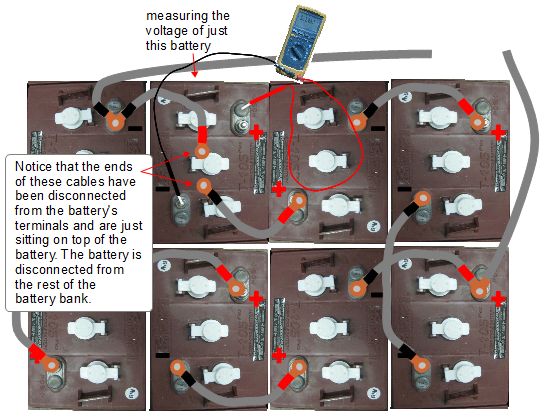Measuring battery bank voltage
Measuring the voltage of a battery bank to find out the state of charge (SOC) is less reliable than measuring the specific gravity, however, if you do it right it at least gives you a quick indication. Once you have measured the voltage, you can look up the SOC using the following table.
| DOD | SOC | 2 volt battery | 12 volt battery | 24 volt battery | 48 volt battery | specific gravity |
|---|---|---|---|---|---|---|
| 0% | 100% | 2.10 | 12.70 | 25.40 | 50.80 | 1.265 |
| 10% | 90% | 2.09 | 12.58 | 25.16 | 50.32 | 1.249 |
| 20% | 80% | 2.08 | 12.46 | 24.92 | 49.84 | 1.233 |
| 30% | 70% | 2.06 | 12.36 | 24.72 | 49.44 | 1.218 |
| 40% | 60% | 2.05 | 12.28 | 24.56 | 49.12 | 1.204 |
| 50% | 50% | 2.03 | 12.20 | 24.40 | 48.80 | 1.190 |
| 60% | 40% | 2.02 | 12.12 | 24.24 | 48.48 | 1.176 |
| Discharged | Discharged | 1.75 | 11.90 | 23.80 | 47.60 | 1.120 |
But make sure that the batteries have not been charging and that there have been no big loads running for at least an hour before you measure the voltage in order to determine the SOC. During this time the battery voltage will be misleading. Certainly during the actual charging or when the load is running the voltage will not represent the SOC. However, these things don't affect the specific gravity of the electrolyte (fluid) in the battery.
If you do look at the voltage while:
- the batteries are being charged the voltage will be higher than normal and will drop after charging is done,
- the batteries are powering loads the voltage will be lower than normal and will rise again after the loads are turned off, and
- the batteries are both being charged and are powering loads then all we can really say is that the voltage is likely higher or lower than normal and will go back to normal after both charging is done and the loads are turned off.
There are two ways to measure battery voltage. The first is from displays on things like inverters, charger controllers, ... The second is using a volt meter. Both of these are talked about below.
Getting the voltage from the inverter, charge controller, ...
Various devices attached to the battery bank will tell you its voltage. As long as you follow the above warning about when to read the voltage then these values will give fair idea of the SOC.
The following photo is of the OutBack MATE which is connected to and OutBack inverter which in turn is connected to the battery bank. This particular voltage reading will vary as described above.
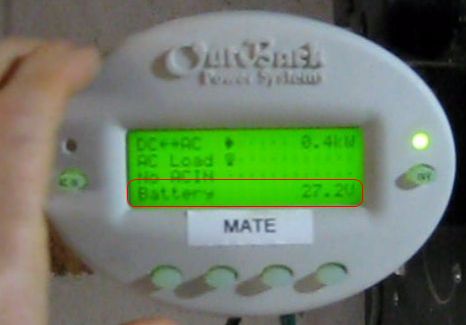
Measuring voltage using a volt meter
You can buy a volt meter at any hardware (e.g. Home Depot, Lowes, ...), electronics store (e.g. Radio Shack), and many automotive stores. They can be very cheap and do the job just fine. Some cost more because they have additional features but all can measure DC voltage. If they can measure more than just voltage then they're referred to as multimeters.
Warning: These batteries contain sulfuric acid. Always wear goggles and rubber or PVC gloves when working with them.
Warning: As a habit, do not touch two battery terminals at the same time with your hands. It's actually safe to do so but batteries and especially many batteries connected together contain a lethal amount of current that can kill you or at least badly burn you. Do not touch two terminals with any metal object (a wrench, screw driver, wire.) If you do you will hear a loud bang, see a bright spark and the metal object will actually melt where it touched a terminal. As a habit, do not sit tools temporarily on top of the batteries or where they can fall onto the batteries.
In the photos below is my very expensive digital multimeter (DMM) but for measuring DC voltage it works just the same way as a cheaper one.
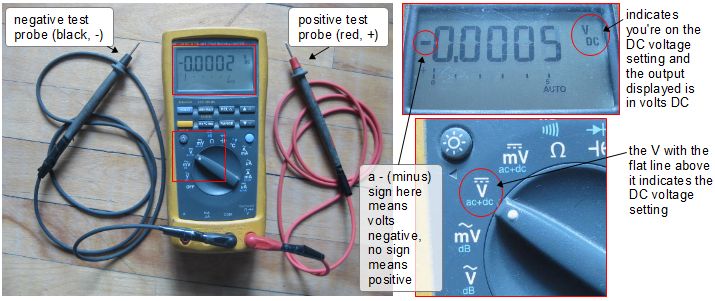
To use it you first select DC voltage on the dial. The photo above shows a typical symbol you'll see that represents DC voltage. The display should then show something like the above indicating DC voltage is being shown.
In the following photo I'm measuring the voltage of only one battery. If you are measuring a battery bank then use the two meter probes the same way as shown in the photo below but put the probes on the the battery bank's positive and negative terminals, as discussed below.
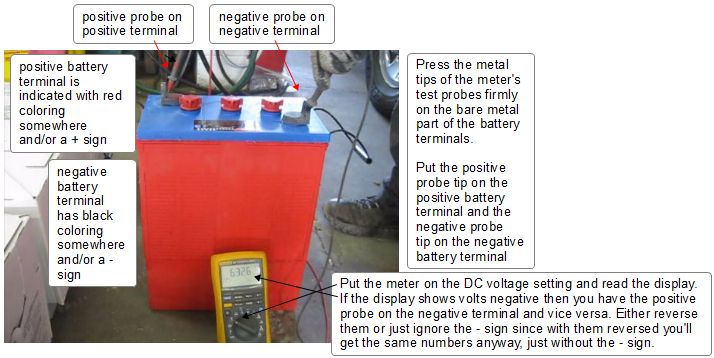
To measure the voltage of the entire battery bank then you need to find the battery bank's positive and negative terminals. These are the terminals that have the cables going to the rest of the solar system (e.g. inverter, charge controller.)
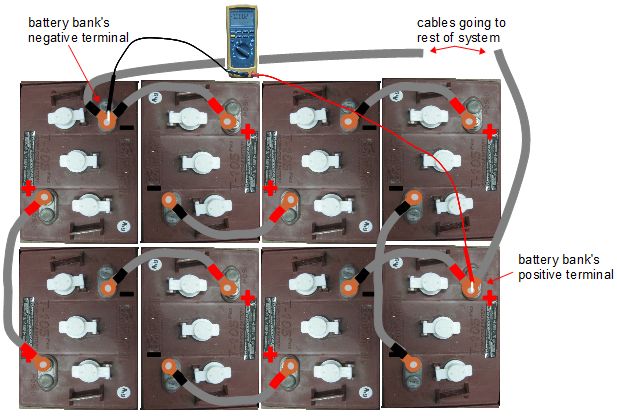
Measuring the voltage of just one battery
If you want to check the voltage of just one battery in a battery bank then you must first disconnect that battery from the battery bank, otherwise the value you read won't represent just that battery's voltage. The following diagram shows you how to do this.
Make sure when you reconnect the cables to the terminals that you tighten them in place very well. The connections need to be very good otherwise you will waste energy and cause uneven charging in the battery bank and possible extra heating in the battery.
